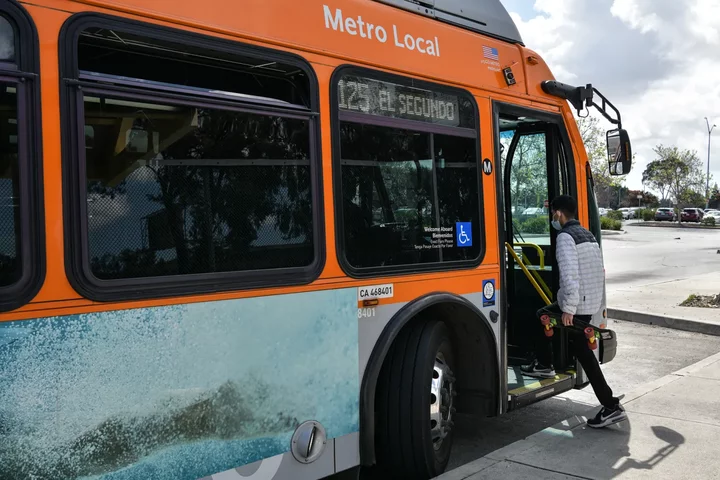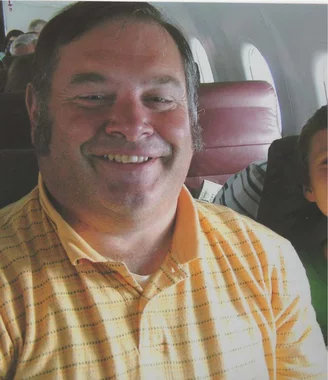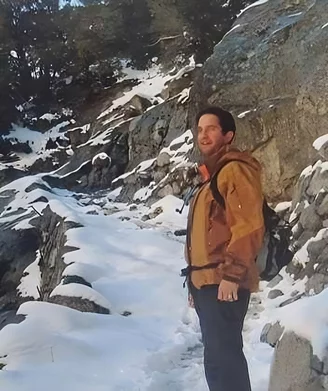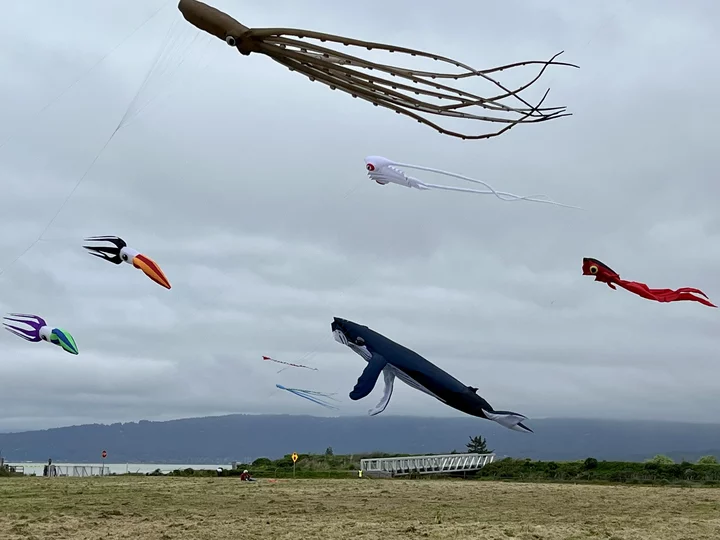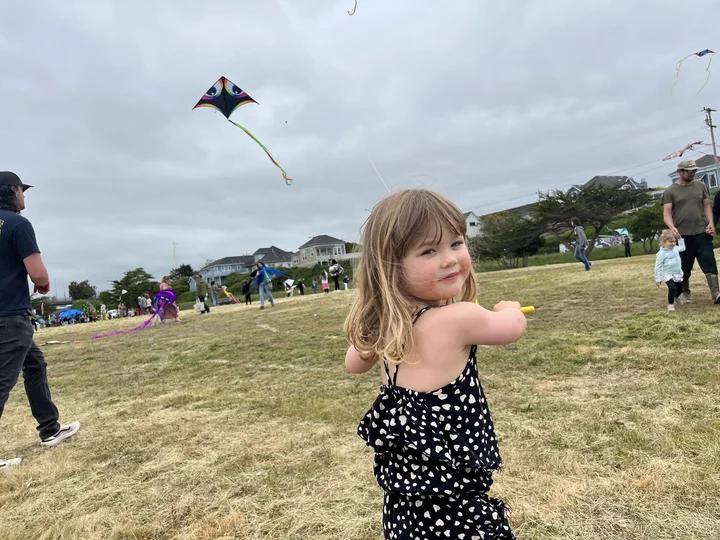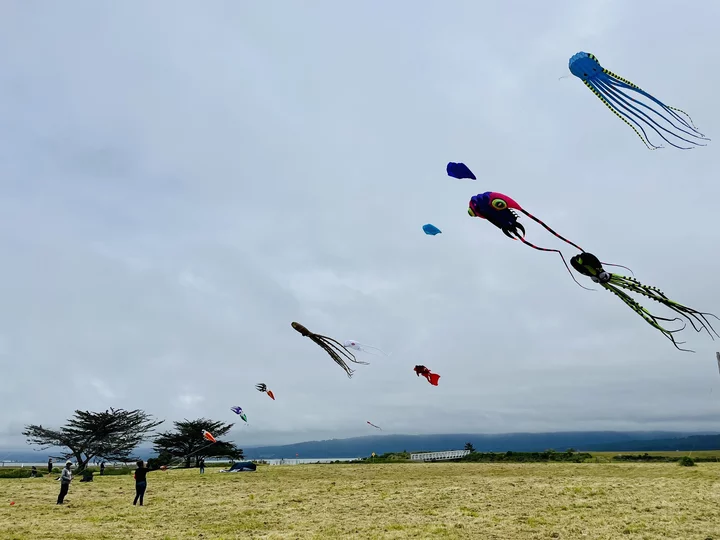How California Public Transit Is Pleading for State Aid
Sameea Kamal / Monday, May 22, 2023 @ 7:37 a.m. / Sacramento
Commuters quickly jump on the Metro bus at the Norwalk Green Line Station in Norwalk on April 3, 2023. Photo by Pablo Unzueta, CalMatters
###
California is grappling with a $31.5 billion budget deficit. Gov. Gavin Newsom denied public transit agencies a lifeline in his latest spending plan, and time is running out.
But transit officials and their supporters in the Legislature aren’t giving up hope yet that the state will offer at least some aid. And Friday, the California Transit Association delivered a plan for how individual agencies should ask for money — and how they would be held accountable for how they spend it.
Transit agencies are seeking $5.15 billion in operating funds over the next five years — warning that without substantial cash, they’ll fall deep into a financial pit caused by a continued decline in ridership since the pandemic and the drying up of federal funds.
Without some kind of financial infusion, Muni — San Francisco’s bus system — may have to start cutting bus lines this summer. Other transit systems are issuing similar dire forecasts.
If services are cut, commuters will be impacted, as will working people who can’t afford their own cars — and certainly not electric vehicles. Increased use of public transit is key to reducing carbon emissions and reaching the state’s climate goals championed by Newsom and Democratic leaders.
But in his updated budget plan unveiled this month, the governor committed only to working with the Legislature to find a solution.
“You can’t do everything,” he said at his May 12 budget briefing. “It’s about balancing other priorities.”
The state Senate wants to make public transit a priority. In its spending proposal, it included the $5.15 billion as “bridge funding.” Supporters say the money can come from a mix of sources that already support transit and would reduce general fund revenue by only $213 million.
TransForm, an advocacy group focused on transit and housing inequities, said it was disappointed in Newsom’s decision.
“The $2.5 billion needed to save Bay Area transit is less costly, in terms of dollars, people, and the planet than the $5 billion in additional transportation costs that will be paid by the people who can least afford it,” said Zack Deutsch-Gross, TransForm policy director.
The budget negotiations are well underway, with a June 15 deadline for the Legislature to pass a budget to keep collecting pay.
Call for help too late?
At a town hall on May 12, Assemblymember Phil Ting, a Democrat from San Francisco and chairperson of the Assembly budget committee, said transit agencies should have been better prepared, and should have “sounded the alarm earlier.”
“Having said that, we are where we are. We can’t change the past,” Ting said.
He said that legislators in the Bay Area Caucus that he leads are focused on the issue and are committed to making sure agencies don’t go over the “fiscal cliff.”
“We know that once these agencies have to stop service, it’s very difficult to turn it back on,” he said.
Ting said that given the budget shortfall, the goal is to help get agencies to solid enough ground to pursue a local ballot measure for long-term financial sustainability.
But he also said that for the state to help, transit representatives needed to present a spending plan and demonstrate accountability.
On Friday, the California Transit Association, which represents agencies throughout the state, responded with its proposal, which includes an 18-month deadline to report how funds are spent. Sent to Newsom and legislative leaders, the blueprint is based on recovery plans previously created by the Bay Area’s regional transportation commission and the Los Angeles Metropolitan Transportation Authority, as well as a bill this session from Burbank-area Democratic Assemblymember Laura Friedman on transit oversight.
The association also noted that its proposal won’t solve all of the underlying issues.
“As we advance this accountability and reform framework, we continue to elevate that significant external challenges will continue to impact agencies’ budgets, operating environments, and ridership levels, including, the hollowing out of downtown cores, the housing crisis, and rise in violent crime,” it said in a statement.
The proposal, however, doesn’t satisfy concerns from some lawmakers, including state Sen. Steve Glazer, who has been vocal in his criticism of BART oversight. BART officials previously responded to some of those concerns, saying the “fiscal cliff” has more to do with the agency’s financial model rather than specific expenses and missteps.
“I thought it was an April Fool’s joke delivered in May,” Glazer told CalMatters of the association’s proposal. “Self-policing is not accountability.” Meanwhile, agencies have already begun to make some changes to boost ridership, including BART ramping up service on its most popular line between Antioch and San Francisco, and L.A. Metro ramping up both homelessness services and microtransit.
But those changes aren’t cheap.
Bevan Dufty, a member of the BART board of directors, said in April: “We really can’t cut our way out of this.”
###
CalMatters.org is a nonprofit, nonpartisan media venture explaining California policies and politics.
BOOKED
Today: 6 felonies, 7 misdemeanors, 0 infractions
JUDGED
Humboldt County Superior Court Calendar: Today
CHP REPORTS
No current incidents
ELSEWHERE
Governor’s Office: Governor Newsom announces appointments 1.13.2026
County of Humboldt Meetings: Humboldt County Behavioral Health Board Meeting - Jan. 22, 2025
OBITUARY: Michael Wayne Dunkelberger, 1954-2023
LoCO Staff / Monday, May 22, 2023 @ 7:06 a.m. / Obits
It is with a
profound sense of loss that we announce the passing of Mike on March
8, 2023. As a lifelong Christian Scientist, we do take comfort in
knowing he has now reached his ultimate, spiritual perfection and his
eternal home in Heaven, no longer bound by his material body.
Michael was born in Missoula, Montana on December 5, 1954, to William Wayne and Imogene Lee Dunkelberger. He was soon followed by two brothers, Paul and Robert. Upon his father’s graduation from Montana State University, the family moved to California where his sister, Wendy, was born. The family finally ended up in Humboldt County after his father took a position with PG&E. Michael lost his father at an early age and after his mother remarried, his youngest brother, Guy, was born.
Michael attended local schools, Elk River School, a one room schoolhouse, South Bay Elementary, Winship Junior High, Eureka High School, graduating in 1973, followed by College of the Redwoods and Humboldt State University.
One thing we can say about Mike is he was always his own man, never a follower. He marched to the beat of his own drum.
Mike was a man of many interests. From an early age he was fascinated by the sciences. Biology and geology were his were his main interests, with Herpetology, the study of reptiles and amphibians, being at the top of the list. While the neighborhood kids were off climbing trees, playing sports or other childhood pursuits, not Mike, he would be found catching frogs and salamanders or digging fossils. Somehow, along the way, we were roped into joining him, wading in swamps, lifting downed trees, seeing what we could find. As an adult, he had a diverse collection of reptiles, large and small.
This love of biology was a lifelong passion for Michael and eventually his career. This led him to continue his study of reptiles and amphibians throughout his life, acquiring a vast knowledge of the subject. Even though biology and herpetology were his passion, he chose to follow in his father’s footsteps and major in geology at HSU. During his time at HSU, Mike worked at Pacific Lumber Company as a millworker, and he would continue this employment after he left HSU. During a conversation with the then-President of Pacific Lumber Company at the annual logging conference, he discussed what he found in the field during his own personal studies. This led to an interview with their biology department, the President telling them they “needed to talk to this guy.” He was hired on the spot. He continued as a wildlife biologist until his retirement in 2018. He loved his job, and we were so proud of him!
Along with herpetology, geology was a huge part of his life. He amassed a large collection of rocks and fossils. Collecting Jade from the local river-bars was a frequent pursuit. He loved the annual gem and mineral show and if you were lucky enough to attend with him, you would inevitably come home with more knowledge about geology and a fossil or two.
Other interests for Michael were airplanes and volcanos. He was an avid photographer with some photographs published in herpetology magazines and books. He was also a member of the American Fuchsia Society for over 25 years.
Michael took immense joy in imparting his knowledge to others. He took any opportunity he could to mentor others about the world and the creatures that live in it. We all learned a lot from Michael. When you needed an answer to anything, you could just ask Mike. The world lost a great mind on March 8th.
Michael’s greatest love was his family. His family meant the world to him, he loved them to “pieces,” and they loved him. Family gatherings were the absolute best. He would bring his special, homemade pies and he always mashed the potatoes! As much as he could, he stayed in touch with his extended family, far and wide.
Michael is survived by his mother, Lee Bravo, and Stepfather, Larry Bravo. Brothers Paul and his children Cliff (Alexis) and Cidnee (Brett), Robert and his children Aaron, Jason, and Serena, Guy Bravo, his wife Tina, and their children Jonathan (Karen), Daniel, David, and Justin. Wendy Heard, her husband Bart and their children, Dylan (Erica), and Sophia. Great niece and nephew Wolf Dunkelberger and Brooklyn Heard, and his beloved cousin, who was like a brother to Mike, Jon Bristow, plus a large, extended family and dear friends.
Michael was predeceased by his father, William Wayne Dunkelberger, his Grandparents, Harold and Luella Dunkelberger, Dwight, and Vesta Claire Bristow. His aunts and uncles, Beverly Lovejoy, Anita Sanders, Dwight and Gary Bristow, Harold (Ben), Chris, and Mason Dunkelberger.
A celebration of life will be on Sunday, June 4, 2023, at the River Lodge, 1800 Riverwalk Dr., Fortuna, CA, beginning at 1 p.m.
In lieu of flowers, if you wish, memorial contributions may be made to the Humboldt Area Foundation, Michael W. Dunkelberger Science Scholarship, to support students pursuing a degree in the sciences or to the charity of your choice.
###
The obituary above was submitted on behalf of Mike Dunkelberger’s loved ones. The Lost Coast Outpost runs obituaries of Humboldt County residents at no charge. See guidelines here. Email news@lostcoastoutpost.com.
OBITUARY: Robert Vincent Syverson, 1966-2023
LoCO Staff / Monday, May 22, 2023 @ 6:59 a.m. / Obits
Robert Vincent Syverson
November 12, 1966 – March 27, 2023
Born in Endicott, New York, Robert was the youngest of four boys. His parents, Marsh and Dian, moved the family to San Jose, when Robert was a young boy, and that’s where he spent the majority of his youth. Robert and his brothers (Mark, Paul and Joe) were blessed to make many lifelong friends on Culver Drive (Traci, Laurie, John, Dave, Wayne, Todd…). Even as the years passed, when they came together, it was just like yesterday. And, thankfully, Robert’s parents sent him to JOY (Jesus Over You) so he could meet his best friend, Derrick and also Randy. Oh, the stories they could tell…years of skiing, lake trips, barbecues, and car shows made memories with lots of laughs and selfies before that was even a thing.
In part due to his rambunctious nature, in his late teens, Robert moved to live with his uncle George in Columbus, Mississippi for a couple years. During that time, they lived on Columbus Air Force Base with George’s family. He quit school and successfully completed his GED. He worked at the base service station. As a young man on the base, he had a dream of being a helicopter pilot, it was then he learned of his glaucoma that caused difficulty over the years. Traveling back to CA to attend his grandfather’s service, Robert took the opportunity to move back to San Jose. He moved in with his parents, and as he told it, his dad told him he had 3 days to get a job and pay rent. And, so he did! Robert worked various jobs from Home Depot to construction project management.
It was at the young age of 21, Robert became the father to Brittany. He was a very caring, giving soul who loved to teach others. He greatly enjoyed and loved raising his daughter. Full of energy as he was, he took her skiing, water skiing, hiking, camping, and to worksites! Robert aligned with the penguin as a way of parenting (the males take care of the young)
A victim of a vehicle accident in his mid-twenties that left him with a serious back injury, Robert had the opportunity to re-evaluate life. He was strong enough to work through the pain from getting off pharmaceuticals with water aerobics and light stretching to eventually mountain biking and jumping the wake, wakeboarding! When Brittany went to live with her mother, Robert hit the reset button. He earned his Associate degree from Evergreen College in San Jose. In 1996 he moved to Arcata to attend Humboldt State University. He graduated with a BS in Natural Resource Planning and maintained a lifelong friendship with roommate Jerry “Bones” Snow.
After graduation, Robert held jobs as a PGE consultant and for the City of Arcata. In 2001 he started his 22-year career with Caltrans, first in planning, then as a field maintenance biologist. He worked all over the district with the Caltrans maintenance crews to protect and enhance the environment when completing maintenance projects, and for storm response. Robert worked in rivers and streams improving fish passage and overall watershed health. Many a tree he planted and saved with creative multidisciplinary solutions. Wildflower surveys made some of his favorite days at work and he took beautiful wildflower photos. A local artist at one time bought his photos to recreate as paintings. As a bicyclist and advocate, he encouraged safe riding on the highways, from contributing to the bicycle touring guides to riding to set timing for bike loops on bridges. Robert’s outgoing personality netted him many colleagues as friends. Most of all, he enjoyed sharing the beauty of protecting the natural world with anyone who would listen. As he called it teaching folks to “pet frogs.”
In 1999, as neighbors at the laundromat, Robert met his future wife, Brenda. She moved to Arizona, where two years later for their birthdays, they took their first of many trips to Sedona, Arizona. Shortly thereafter, Brenda moved back to Humboldt where she and Robert joined their cat families (Weather, Sprocket, and KBear) along with tortoise Kokopelli. Robert was a very kind, supportive, and chivalrous partner, which garnered him many compliments from strangers over the years. They took pleasure in an active lifestyle, from: mountain biking, hiking, house boating, wakeboarding, to gardening, evening walks, and plant identification. They loved to travel, stay in swanky places and eat fancy food. Some of their favorite trips included Utah (Gooseberry, LaVerkin, Zion), Arizona (Grand Canyon, Sedona!). Mt. Hood, Yosemite, New York, Southern Oregon coast, Fort Bragg and various hot springs! They resided in Fortuna for 15 years and found the most amazing, supportive neighbor friends (Brandon and Lluvia, Noah, Eli, Jim and Terry, Aaron, Mark, Debi and Mike, Penny, Mr. McKnight and others). Robert and Brenda’s union of marriage ended in 2019, however the love remained.
Robert loved life, and all living things. An energetic, talkative, friendly, outgoing personality, Robert touched the lives of many (human, plant, animal…). And, if I were to be reincarnated, I would want to be Robert’s cat! In honor of Robert: ride your bike, stop and smell the flowers, watch the sunset, talk to strangers, pet a frog, smile, laugh, hug trees and those you love, be your own fearless medical advocate, practice self-care.
Robert is survived by mother Dian Syverson; brothers Mark Syverson (Mary Jean) and Joe Syverson (Anafe); uncles George Refeedie and Marlo Syverson; cousins Ali Colton Syverson, Shannon Primasing (David); daughter Brittany Loofbourrow; niece Danielle; nephews Joey, Tommy, Matthew; and many other cousins and second cousins.
Robert was proceeded in death by father Marschelle Syverson and brother Paul Syverson.
###
The obituary above was submitted on behalf of Robert Syverson’s loved ones. The Lost Coast Outpost runs obituaries of Humboldt County residents at no charge. See guidelines here. Email news@lostcoastoutpost.com.
(PHOTOS/VIDEO) Flyin’ High at the Second Annual Redwood Coast Kite Festival
Stephanie McGeary / Sunday, May 21, 2023 @ 12:17 p.m. / Event
One of the kite performances synced to music at the Redwood Coast Kite Festival | Photos, video: Stephanie McGeary
###
It’s a bird…it’s a plane…it’s a giant whale flying above Eureka!
You may have noticed kites in the shape of whales, squid, fish and and all sorts of other creatures and shapes flying near the Eureka’s waterfront this weekend. That’s because the second annual Redwood Coast Kite Festival has taken over Halvorsen Park for two days of kite-centered fun!
This is the second year of the kite festival in Eureka, put on by Humboldt Kiters, a DreamMaker project of the Ink People. Mark Ahrens, local kite enthusiast and event coordinator for the festival, told the Outpost on Saturday that the turnout for the festival was very good and that it is starting to become well-known among avid kiters across the country.
“We’ve become a destination point,” Ahrens said during a quick interview on Saturday afternoon. “It’s pretty awesome because the kiting community has said ‘this is the real deal.’”
The festival, Ahrens added, is actually a reboot of the original Redwood Coast Kite Festival that started on the Samoa Peninsula in 1992 and was eventually moved to southern Oregon. Like so many events, the festival was canceled during the pandemic and has not returned since. The idea to bring the festival back came about after some local kiters started meeting in Halvorsen Park during COVID lockdown. Ahrens said that it started with just a couple people and then, as people realized it was a fun and safe activity to do outdoors during COVID, the kiter group grew larger.
After learning that the Oregon kite festival would not be coming back post COVID, Ahrens and a group of other local kiters decided that they needed to fill the void. They started the nonprofit Humboldt Kiters and put together the festival and Halvorsen Park in 2022.
This year, the festival has grown to include more professional kite performances with sport kites, food vendors and a wellness area with a blood mobile and DHHS booth. There were also artisan vendors selling local clothing, jewelry, crafts and — of course — kites!
If you missed the event on Saturday, the Redwood Coast Kite Festival continues at Halvorsen Park in Eureka today (Sunday, May 21) until 5 p.m.
“Come on out and have fun,” Ahrens said.
Scroll down for a few more photos.
GROWING OLD UNGRACEFULLY: I Don’t Do Fiction
Barry Evans / Sunday, May 21, 2023 @ 7 a.m. / Growing Old Ungracefully
My stock response, when someone asks me if I write fiction or non-fiction, is something like, “Well I hope it’s non-fiction.” Fiction eludes me, and I marvel at and respect those who tackle it — we have several talented and successful fiction writers right here in Humboldt County.
My problem with fiction is this: I’ll have what I (a legend in my own mind) think of as a brilliant start. Sometimes it’s just a sentence, other times a paragraph or two, or a few lines of dialog. Then, perhaps 100 words in, I’ll run out of steam.
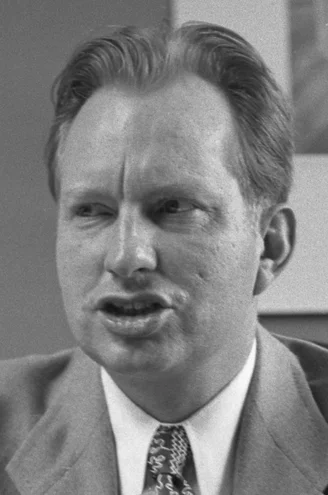
L. Ron Hubbard, the champ. Photo: Public domain, via Wikimedia.
100 words! Here’s what real writers output, daily.
- Anne
(Interview with a
Vampire) Rice: 3,000
words
- Michael (Jurassic Park) Crichton: 10,000 words
- Ernest Hemingway: 500 words (but what words!)
- Stephen King: 2,000 words
- L. Ron Hubbard, founder of Scientology, published 1084 works (250 fiction) in his lifetime, making him the world’s most prolific writer according to Guinness.
Making my efforts look a bit silly. But I have a column to write, so here are some recent efforts for you to waste the next five minutes on. Or not. As I say, I don’t do fiction.
God’s Barber
Over the millennia, Julce’s drinking problem got worse and worse. Every hundred thousand years or so, he’d try to quit, but sobriety never took, and he was the only one God trusted with his beard, so he kept his job despite his addiction. It all came to a head the day Junior (as the angels insisted on calling Him) arrived, ascending in a cloud of glory, seraphim and cherubim ushering Him up through the clouds. And oh my, was he a mess! He’d never washed up after His messy demise — hands and feet were particularly disgusting — and His hair was still matted with blood from the thorns. It fell to Julce to clean him up…
…who was having a particularly bad day, having stumbled on a jar of fermented manna the previous evening.
Jasmine
“Excuse me, but aren’t you the the guy in that movie?”
I gave her an enigmatic smile.
“My God! You are! I loved it, especially the scenes with, um, Jennifer?”
“She was a lot of fun to work with,” I said, trying to sound discreet.
“Would you mind terribly if I got a selfie with you?”
Up close, she smelled of jasmine.
“Look, I know it’s crazy, but…”
“It’s OK, I’m traveling incognito. Even my agent doesn’t know I’m here. Dinner?”
She gave a little whinny.
I love being the guy who looks like the guy in that movie.
Nine of Hearts
When I was an aspiring magician, I barely missed a single show of Harry’s. Afterwards, I’d tell him how I thought he did it, figuring out almost all of his illusions. I begged for more.
“Buy a deck of cards, pick one and put it in your pocket.”
We met the following night: “Nine of hearts.”
“How…?” I spluttered.
He put his finger on the side of his nose. “Shtum.”
Yesterday I visited him, a frail old man in his hospital bed.
“Harry, I’ve been going crazy for 40 years. How did you do it?”
He smiled. “I guessed.”
Three False Starts
“Time to wake up,” she thought, “This dream’s been going on for far too long.” But…
###
“It’s going to be another long night,” said the waiter at the all-night coffee shop. He glanced over at the foursome in the corner of the restaurant. I looked at the black-leather clad gaggle of teens, not seeing anything out of the ordinary, until I realized…
###
Something about the envelope made me anxious. No return address, just my name and address scrawled in purple ink. How did they know my first name? Everyone here knows me by my middle name, yet here it was, “Philip Barry Evans,” large as life. I tore open the envelope…
HUMBOLDT TEA TIME: Arcata Mayor Sarah Schaefer Tells Us About Governing Her Home Town in an Age of Potentially Transformative Growth
LoCO Staff / Saturday, May 20, 2023 @ 3 p.m. / People of Humboldt
She was born in Arcata. Now she’s the mayor!
Today on Humboldt Tea Time, host John Kennedy O’Connor is honored to be joined by Sarah Schaefer, an Arcata native who became a high school teacher and then mayor of the whole goddamn town.
What led her into public service? What’s it like to be involved in Arcata government, at a time of great transformation in the city, and in the county generally? How is the city getting along with Cal Poly Humboldt, and with its neighboring communities? Will she seek reelection next year, and will that decision be affected by whether or not she can afford to buy a house in her home town?
Today’s official tea time snack is Sweet Potato and Goat Cheese Bites, which you will make with Cypress Grove, of course. Tuck in, press play.
THE ECONEWS REPORT: Protecting 30% of California by 2030
The EcoNews Report / Saturday, May 20, 2023 @ 10 a.m. / Environment
California has set a bold conservation goal to protect 30% of its lands and coastal waters by 2030. This “30x30” goal aligns with a global 30×30 movement to protect nature all around the world to avoid an extinction crisis.
The Power in Nature Coalition brings together environmental organizations, activists, and tribal nations to collectively push Sacramento to meet its 30x30 target. Advocates are urging the state to fund and protect key strategic lands and waters that will protect biodiversity, allow for better public access to the outdoors, and help to naturally sequester carbon. Josefina Barrantes of the Power in Nature Coalition joins Dan Sealy of the NEC and Matt Simmons of EPIC to chart a path forward for conservation.

